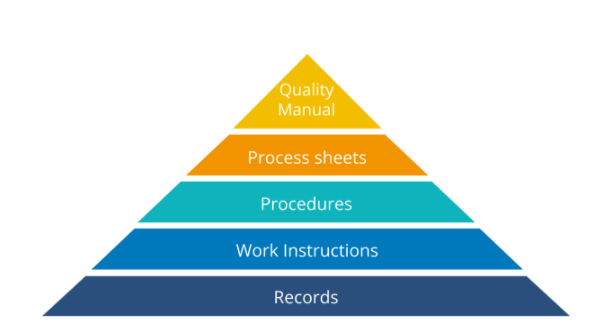Electronic Document Management (EDM) is the QMS basis and every organization must have a well-functioning documentation system as part of their quality process. Using a paper based system can be time-consuming and error-prone. This is why electronic tools exist.
What are the advantages of EDM and how to implement it?
According to a McKinsey report, employees spend an average of 1.8 hours per day, or 9.3 hours per week, searching for and collecting information. Digitising documents so they are immediately available creates value for employees to unleash their productivity..
In the digital age, this notion of documentation linked to paperwork has been phased out and replaced by Electronic Document Management systems accessible on different formats such as smartphones or tablets. A change powered by the desire to optimize organization performance at its best.
How is the quality documentation organized?
The quality documentation system is made up of different documents with a specific rank and degree of importance. They are structured like a pyramid: from the top, which is the quality policy, to the bottom, which is a set of various recording documents such as registration forms and so on...

Figure 1 - QMS Documentary pyramid
Let's see what each layer of the pyramid represents:
- The quality manual: this document is the first document of the Quality Management System of a company. It is a summary document that defines how a quality approach fits into the overall business strategy.
According to the latest version of ISO 9001, the quality manual is no longer a mandatory document. - Process sheets: this is a document that gathers the necessary information for a complete understanding of the scope of activities of each process, the input elements that trigger the initiation of the process, the output elements and their expected level of performance.
- Procedures: they formalize how one or more activities are to be carried out in the company. They define precisely who does what, how, where and why.
- Work instructions: work instructions and operating procedures complete the procedures by detailing each of the tasks described in the process.
- Records: their function is to prove the results of operations and to ensure their traceability (proofs and traces).
The traditional documentation management
It is a document management system that consists of keeping documents on paper, servers or hard disks. Documents are generally in Word, Excel or PDF formats and are most of the time classified manually. This is a time-consuming activity and managing the different versions and updating documents can be difficult.
This system presents several risks and disadvantages in the management of company data:
- Poor centralization of data: Centralizing documents is essential to ensure optimal performance. Within each company, all people participate in the filing and sorting out of documents. In every company, everyone is involved in filing and sorting documents. This activity is often a source of errors, such as creating multiple versions or filing the same document several times. In addition, each team member has their own classification logic and method, which could cause a problem for another team member to find themselves in a classification method that is not their own.
- Traceability problems: A deficiency of document traceability or even a total absence of visibility on the updating part of documents.
- Limited control over diffusion: the management of the life cycle of these printed paper versions is very complex in terms of diffusion and destruction.
So, when the traditional document management system of a company is not optimized, the company is exposed to risks that could affect its performance and even the satisfaction of its customers.
These risks are reflected by: the waste of employees' time looking for documents or information, the cost of managing the paper archives, or the security and integrity of company data.
This is why we will see that EDM is a major ally in this process.
Electronic Document Management and its functionalities
EDM is a software solution for managing the lifecycle of an electronic document from its creation, storage, diffusion, to archiving or destruction, if applicable. It supports the management of document flows within an organization.
EDM offers a diverse range of functions:
- Classification of documents, based on indexing or tagging, which consists in describing the document (type, author, title, source, date, etc.) or according to their content (keywords), to facilitate its use.
- The diffusion of documents or information in electronic form can be done through the Internet or Intranet.
- The integration of existing documents onto the software via their digitization using photos or scan versions, the integration of existing electronic documents and the production of new electronic documents.
- Archiving, which consists in classifying documents that are no longer relevant for current operations but that must be kept. The indexing or tagging of archived documents should facilitate their access.
These various functions primarily allow EDM to ensure that each team member has dedicated and secure access, for reliable management of documents and information.
EDM is also a tool that saves employee’s time through an immediate access to electronic versions of each document via a search bar, and at the same time to reduce the costs associated with physical archiving.
EDM facilitates documents processing and distribution: team members are automatically notified by e-mail when an update or new version of the document is available.
This tool also allows users to set color codes to have visibility over changes made from one document version to another, while being able to consult the corresponding history.
EDM is a technological advance in terms of optimizing document management, it offers useful and convenient functionalities for companies that aspire to optimize their performance. It is a change that companies have to go through if they still want to compete in today’s market.
Switching from a traditional document management system to an EDM is not easy. However, this approach ensures a better distribution of information, especially in a context of remote work where companies have had to adapt accordingly.
. . .





